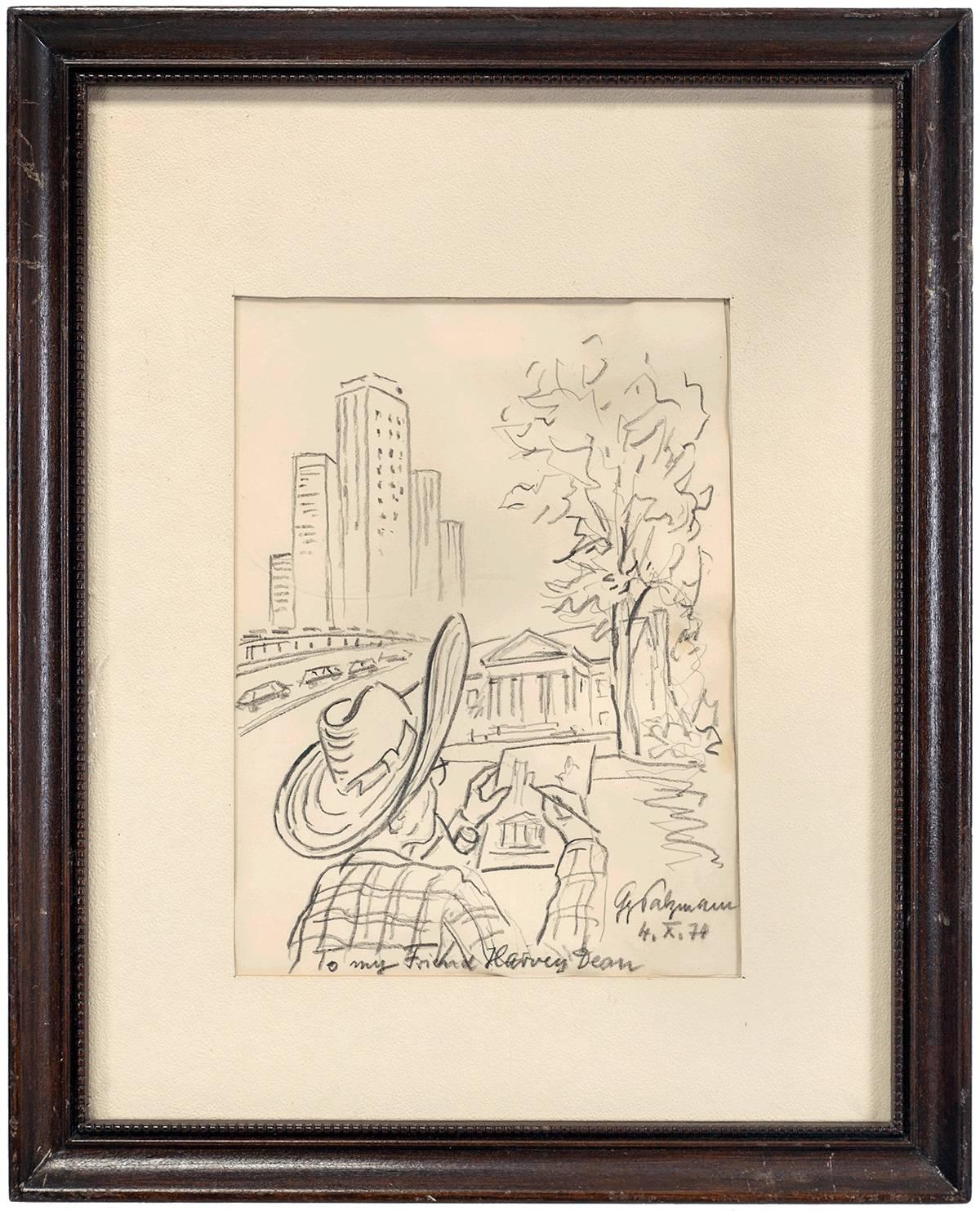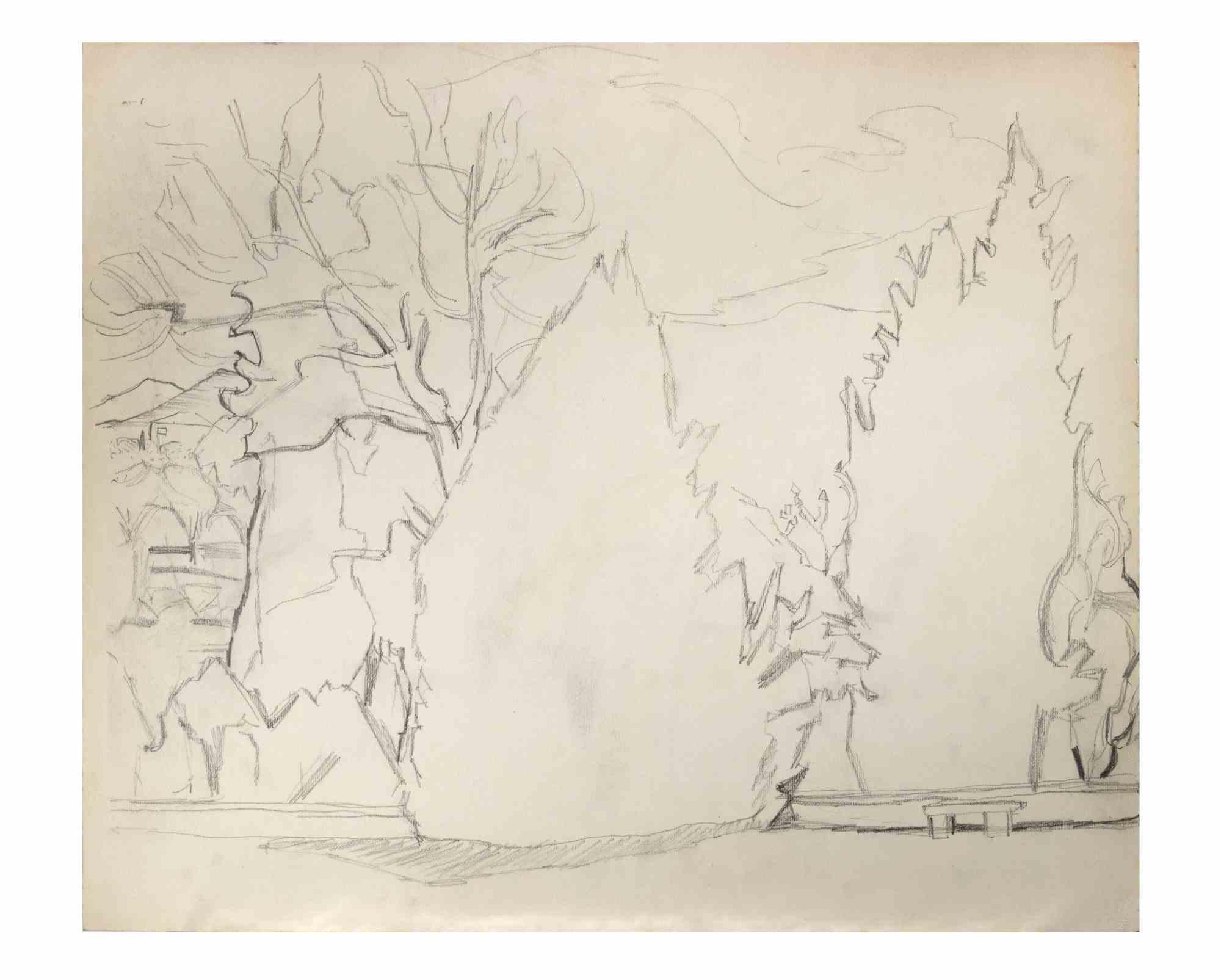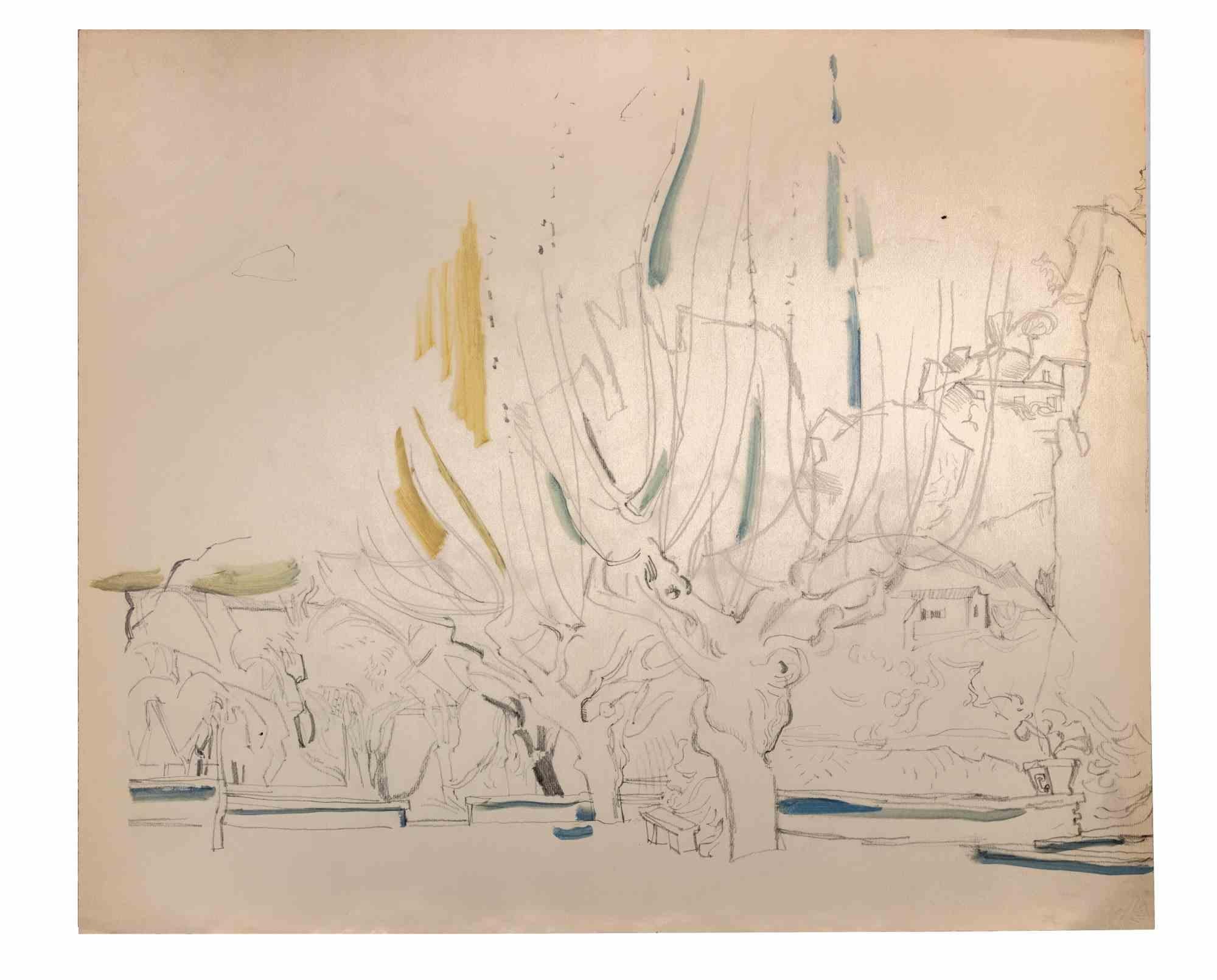Items Similar to San Tubisco (Season's Greetings) Holiday Drawing Artwork Poseidon Trident Bridge
Want more images or videos?
Request additional images or videos from the seller
1 of 5
Gottfried SalzmannSan Tubisco (Season's Greetings) Holiday Drawing Artwork Poseidon Trident Bridge1974
1974
About the Item
Gottfried Salzmann , born on 26 March 1943 In Saalfelden near Salzburg in Austria is an Austrian painter. He lives and works in France (between Paris and Vence) since 1965.
He studied from 1963 to 1965 at the school of fine arts of Vienne and then, from 1965 to 1968, at the Beaux-Arts of Paris. He exhibited for the first time in 1969 in Salzburg.
He paints in watercolor, is also a draftsman, an engraver and a photographer; He sometimes painted on his pictures when he left the watercolor.
In 1989, he illustrated by lithographs Situations de New York by Jean-Paul Sartre (edition Les Bibliophiles de France ).
Prizes:
1972: David-Weill Drawing Prize, Paris - Theodor Körner Prize, Vienna
1975: Grand Prize of drawing of the "Salzburger Wirschatskammer"
1977: 1st international prize for watercolor in Rome.
Exhibitions:
Personal exhibitions
Germany: Krefeld (Galerie Peerlings), Düsseldorf (Galerie Walther), Cologne (Galerie Boisserée), Munich (Galerie Gunzenhauser, Galerie Seifert-Binder), Hamburg (Lochte Gallery), Darmstadt Gallery Frankfurt, Stuttgart, Mainz, Schweinfurt, Nüremberg (photographs), Aachen
England: London (Albermale Gallery)
Steyr, Innsbruck (Bloch Gallery, Maier Gallery), Lusteneau (Galerie Neufeld), Klagenfurt (Austria), Vienna (Galerie Würthle, Galerie Stubenbastei, Gallery Contact), Salzburg (Gallery Welz), Linz (Oberösterreichisches Kunstverein, (Künsterhaus, Slama Gallery), Graz, Bozen
Belgium: Brussels
United States: New York (Austrian Institute, KPF Gallery, Franklin Bowles Gallery), Washington DC (Bader Gallery)
France: Paris (Galerie Flak, Gallery of the Atelier Lambert, Galerie l'Œil Sévigné, City Hall, Galerie Nichido, Galerie Étienne de Causans, Galerie Arcturus, Rouen (Center of Contemporary Art), Aachen, Amiens (House of Culture), Deauville, Tours
Hungary: Budapest
Japan: Tokyo (Nichido Gallery), Fukuoka (Nichido Gallery)
Liechtenstein: Vaduz (Haas Gallery)
Philippines: Manila
Poland: Warsaw
Switzerland: Bern (Galerie Vita), Basel, Lausanne, Friborg (Galerie Ollier)
Latest exhibitions [ edit Change the code ]
2009:
Gallery New Art City, Lille
Engravings, photo-forts, watercolors, Métairie Bruyère, Parly (89240)
In museums:
1973: House of the culture of Amiens
1982: Museum of the Albertina of Vienna
1987: Staatliche Sammlungen Schweinfurt
1991: Oberösterreichisches Landesmuseum Linz; Metropolitan Museum of Manila; Museum of Modern Art of the Rupertinium of Salzburg
1993: Museum of the Seita, Paris
1996: Center of contemporary art of Rouen (with Nicole Bottet)
1998: Benedictine Palace , Fécamp
2001: Museum of Saint-Maur-des-Fossés, The Varenne
2003: Carolino Augusteum Museum of Salzburg
2006: Inauguration of the Gottfried Salzmann Hall at the Carolino Augusteum Museum in Salzburg
- Creator:Gottfried Salzmann (1943, Austrian)
- Creation Year:1974
- Dimensions:Height: 13.25 in (33.66 cm)Width: 9.25 in (23.5 cm)
- Medium:
- Movement & Style:
- Period:
- Condition:
- Gallery Location:Surfside, FL
- Reference Number:1stDibs: LU38213828352
About the Seller
4.9
Platinum Seller
These expertly vetted sellers are 1stDibs' most experienced sellers and are rated highest by our customers.
Established in 1995
1stDibs seller since 2014
1,560 sales on 1stDibs
Typical response time: 1 hour
- ShippingRetrieving quote...Ships From: Surfside, FL
- Return PolicyA return for this item may be initiated within 3 days of delivery.
More From This SellerView All
- TO MY FRIEND HARVEY DEAN....By Gottfried SalzmannLocated in Surfside, FLGottfried Salzmann , born on 26 March 1943 In Saalfelden near Salzburg in Austria is an Austrian painter. He lives and works in France (between Paris and Vence) since 1965. He studied from 1963 to 1965 at the school of fine arts of Vienne and then, from 1965 to 1968, at the Beaux-Arts of Paris. He exhibited for the first time in 1969 in Salzburg. He paints in watercolor, is also a draftsman, an engraver and a photographer; He sometimes painted on his pictures when he left the watercolor. In 1989, he illustrated by lithographs Situations de New York by Jean-Paul Sartre (edition Les Bibliophiles de France ). Prizes: 1972: David-Weill Drawing Prize, Paris - Theodor Körner Prize, Vienna 1975: Grand Prize of drawing of the "Salzburger Wirschatskammer" 1977: 1st international prize for watercolor in Rome...Category
20th Century Modern Figurative Drawings and Watercolors
MaterialsPaper, Pencil
- Boston Abstract Expressionist Hyman Bloom Original Pencil Drawing Martin SumersBy Hyman BloomLocated in Surfside, FLThis is a unique artwork. This is an original Hyman Bloom drawing of fellow artist and his very good friend Martin Sumers.I believe this was drawn at the “variations of a theme” at Sumers gallery in NYC. The last two photos show a poster and a card from their shows. it is not included in this listing, it is just for provenance. Provenance: Acquired from the Sumers estate collection. Hyman Bloom (March 29, 1913 – August 26, 2009) was a Latvian-born American painter. His work was influenced by his Jewish heritage and Eastern religions as well as by artists including Altdorfer, Grünewald, Caravaggio, Rembrandt, Blake, Bresdin, James Ensor and Chaim Soutine. He first came to prominence when his work was included in the 1942 Museum of Modern Art exhibition "Americans 1942 -- 18 Artists from 9 States". MoMA purchased 2 paintings from the exhibition and Time magazine singled him out as a "striking discovery" in their exhibition review. His work was selected for both the 1948 and 1950 Venice Biennale exhibitions and his 1954 retrospective traveled from Boston's Institute of Contemporary Art to the Albright Gallery and the de Young Museum before closing out at The Whitney Museum of American Art in 1955. In a 1954 interview with Yale art professor Bernard Chaet, Willem de Kooning indicated that he and Jackson Pollock both considered Bloom to be “America’s first abstract expressionist”, a label that Bloom would disavow. Starting in the mid 1950s his work began to shift more towards works on paper and he exclusively focused on drawing throughout the 1960s, returning to painting in 1971. He continued both drawing and painting until his death in 2009 at the age of 9 Hyman Bloom (né Melamed) was born into an orthodox Jewish family in the tiny Jewish village of Brunavišķi in what is now Latvia, then part of the Russian Empire At a young age Bloom planned to become a rabbi, but his family could not find a suitable teacher. In the eighth grade he received a scholarship to a program for gifted high school students at the Museum of Fine Arts. He attended the Boston High School of Commerce, which was near the museum. He also took art classes at the West End Community Center, a settlement house. The classes were taught by Harold Zimmerman, a student at the School of the Museum of Fine Arts, who also taught the young Jack Levine at another settlement house in Roxbury. When Bloom was fifteen, he and Levine began studying with a well-known Harvard art professor, Denman Ross, who rented a studio for the purpose and paid the boys a weekly stipend to enable them to continue their studies rather than take jobs to support their families. He took Bloom and Levine on a field trip to the Museum of Modern Art in New York, where Bloom was impressed by the work of Rouault and Soutine and began experimenting with their expressive painting styles. In the 1930s Bloom worked sporadically for the Public Works of Art Project and the Federal Art Project (WPA), He shared a studio in the South End with Levine and another artist, Betty Chase. It was during this period that he developed a lifelong interest in Eastern philosophy and music, and in Theosophy. He first received national attention in 1942 when thirteen of his paintings were included in the Museum of Modern Art (MoMA) exhibition Americans 1942: 18 Artists from 9 States, curated by Dorothy Miller. MoMA purchased two of his paintings from that exhibition, and he was featured in Time magazine. The titles of his paintings in the exhibition reflect some of his recurring themes. Two were titled The Synagogue, another, Jew with the Torah; Bloom was actually criticized by one reviewer for including "stereotypical" Jewish images. He also had two paintings titled The Christmas Tree, and another titled The Chandelier, both subjects he returned to repeatedly. Another, Skeleton (c. 1936), was followed by a series of cadaver paintings in the forties, and The Fish (c. 1936) was one of many paintings and drawings of fish he created over the course of his career. Bloom was associated at first with the growing Abstract Expressionist movement. Willem de Kooning and Jackson Pollock, who first saw Bloom's work at the MoMA exhibition, considered Bloom "the first Abstract Expressionist artist in America." In 1950 he was chosen, along with the likes of de Kooning, Pollock, and Arshile Gorky, to represent the United States at the Venice Biennale. That same year Elaine de Kooning wrote about Bloom in ARTnews, noting that in paintings such as The Harpies, his work approached total abstraction: "the whole impact is carried in the boiling action of the pigment". In 1951 Thomas B. Hess reproduced Bloom's Archaeological Treasure in his first book, Abstract Painting: Background and American Phase, along with works by Picasso, Pollock, and others. Both de Kooning and Hess remarked on Bloom's expressive paint handling, a key characteristic of Abstract Expressionist painting. As abstract expressionism dominated the American art world, Bloom became disenchanted with it, calling it "emotional catharsis, with no intellectual basis." In addition, instead of moving to New York to pursue his career, he opted to stay in Boston. As a result he fell out of favor with critics and never achieved the kind of fame that Pollock and others did. He disliked self-promotion and never placed much value on critical acclaim. Many of Bloom's paintings feature rabbis, usually holding the Torah. According to Bloom, his intentions were more artistic than religious. He began questioning his Jewish faith early in life, and painted rabbis, he claimed, because that was what he knew. Over the course of his career he produced dozens of paintings of rabbis...Category
20th Century Modern Figurative Drawings and Watercolors
MaterialsPaper, Pencil
- Ken Aptekar Contemporary Conceptual Judaica Art Drawing Go Study Chasidic RabbisBy Ken AptekarLocated in Surfside, FLKen Aptekar American (b. 1950) Go Know (Study) 1996 Graphite, white pigment, transparency film, and staples on paper Hand signed lower right sheet: 18 x 18 inches frame dimensions:...Category
Late 20th Century Conceptual Mixed Media
MaterialsPaper, Film, Graphite, Pigment
- Old Jewish Shtetl Rabbi Charcoal Judaica Drawing World War II EraBy Maurycy TrebaczLocated in Surfside, FLMaurycy Trębacz (1861 – 1941) was one of the most popular Jewish painters in Poland in the late 19th and early 20th century. Many of his paintings were lost in the Holocaust, but a representative selection of his artwork survived.Trębacz died of starvation in the Litzmannstadt Ghetto during the Nazi German occupation of Poland. Maurycy Trębacz, along with Samuel Hirszenberg, Jakub Weinles, and Leopold Pilichowski, belonged to the first generation of Jewish artists in Poland who broke away from the religious prohibition on portraying a human figure (see below). The studies show his mastery of painting, his own unique style and great imagination. Trębacz was noted within the European art-world as a master portrait and landscape painter,[1] but above all he was also a rare chronicler of the contemporary Jewish life, depicting a world that is now lost. His popular subjects included praying Rabbis, old men, street and Jewish domestic scenes, and genre painting depicting the everyday side of life. His psychological portraits of Jews earned him the greatest popularity and critical acclaim, and influenced the work of other Jewish painters in Poland. Notably, Trębacz's oil painting "The Good Samaritan", reportedly stolen in 1904 at the World's Fair, was recently sold at auction at Sotheby's. Born in 1861 in Warsaw, the son of David Trębacz, a house painter, Maurycy (Mojżesz) at the age of 16 years was admitted to the school of drawing by professor Wojciech Gerson and Aleksander Kamiński. Three years later, with the support of Leopold Horowitz, he received a scholarship sponsored by lawyer Stanisław Rotwand, and moved to Kraków where he enrolled in the Academy of Fine Arts in the studios of Jan Matejko, Leopold Loeffler and Władysław Łuszczkiewicz. From 1882, he studied at the Academy of Fine Arts in Munich with Sandor Wagner (until 1884) and received the grand silver medal there at the completion of his studies for the work "Martyrdom". Between 1889 and 1890, he studied in Paris at the Académie Colarossi. He lived and worked in Munich for 4 years before returning to Warsaw. Over time, Trębacz worked in Lviv and Drohobych, and eventually moved permanently to Łódź, where he founded and ran a private art school until September 1939. He is often criticized for giving in to popular demand later on in his career. Pressured by financial sponsors, he began to produce sentimental theme portraits pertaining to the bucolic life of country folk. Trębacz made his successful artistic début twice, first at the Munich Kunstverein, and then at the Krywult Salon in Warsaw as a 23-year-old painter. His another big success was the participation of painting "Good Samaritan" (1886, pictured) in a Kunstverein exhibition in Munich as well as at the I National Art Exhibition in Kraków and in Warsaw at the Zachęta Society for the Promotion of Fine Arts. The painting was also awarded a gold medal at the Universal World Exposition in Chicago. Subsequently, Trębacz also received a bronze medal at the Paris Universal World Exposition of 1889. "Good Samaritan" (1886), book engraving from painting by Maurycy Trębacz, Warsaw Maurycy Trębacz died of hunger in the Łódź Ghetto...Category
1930s Expressionist Figurative Drawings and Watercolors
MaterialsPaper, Charcoal, Graphite
- Dennis Oppenheim Large Abstract Conceptual Sculpture Drawing for Ace Gallery LALocated in Surfside, FLDennis Oppenheim (1938 - 2011) Pencil and colored pencil drawing on paper, 'Memory Generator Receiver; Transmitter project for ACE Gallery Los Angeles' (possibly with watercolor pai...Category
1970s Abstract Drawings and Watercolors
MaterialsPaper, Pencil, Color Pencil
- William Anthony 1992 Caricature Drawing Will You Marry Me?By William AnthonyLocated in Surfside, FLWilliam Anthony, born 1934, Forth Monmouth, NJ. and grew up in Washington State. Education 1958 Yale, New Haven, CT, B.A European History 1959-60 San Francisco Art Institute, CA 196...Category
1990s Contemporary Figurative Drawings and Watercolors
MaterialsPaper, Pastel, Pencil
You May Also Like
- Landscape - Drawing By Reynold Arnould - Mid-20th centuryLocated in Roma, ITLandscape is a pencil drawing realized by Reynold Arnould (Le Havre 1919 - Parigi 1980). Good condition. No signature. Reynold Arnould was born in Le Havre, France in 1919. He s...Category
Mid-20th Century Modern Landscape Drawings and Watercolors
MaterialsPaper, Pencil
- Landscape - Drawing By Reynold Arnould - Mid-20th centuryLocated in Roma, ITLandscape is a pencil drawing realized by Reynold Arnould (Le Havre 1919 - Parigi 1980). Good condition. No signature. Reynold Arnould was born in Le Havre, France in 1919. He stu...Category
Mid-20th Century Modern Landscape Drawings and Watercolors
MaterialsPaper, Pencil
- Landscape - Drawing By Reynold Arnould - Mid-20th centuryLocated in Roma, ITLandscape is a pencil drawing realized by Reynold Arnould (Le Havre 1919 - Parigi 1980). Good condition. No signature. Reynold Arnould was born in Le Havre, France in 1919. He st...Category
Mid-20th Century Modern Landscape Drawings and Watercolors
MaterialsPaper, Pencil
- Cityscape - Drawing By Reynold Arnould - 1970Located in Roma, ITCityscape is a Pencil and Watercolour Drawing realized by Reynold Arnould (Le Havre 1919 - Parigi 1980). Good condition. No signature. Reynold Arnould was born in Le Havre, Franc...Category
1970s Modern Figurative Drawings and Watercolors
MaterialsPaper, Pencil, Watercolor
- Portrait - Drawing By Reynold Arnould - Mid-20th CenturyLocated in Roma, ITPortrait is a Pencil Drawing realized by Reynold Arnould (Le Havre 1919 - Parigi 1980). Good condition included a white cardboard passpartout (70x51 cm). No Signature, another pen...Category
Mid-20th Century Modern Portrait Drawings and Watercolors
MaterialsPaper, Pencil
- Au Cimetière Monsieur- Pencil and Watercolor on Paper by F. Picabia - 1931By Francis PicabiaLocated in Roma, ITAu Cimetière Monsieur... is a black pencil and watercolor drawing realized by Francis Picabia in 1931. Hand signed lower left, with title lower right. A certificate of inclusion in the Catalog Raisonné being prepared by the Picabia Committee, dated 30 October 2019, will be delivered in original along with the work. Drawing originally realized by Picabia to illustrate the important volume "Le Peseur d'Ames" by André Maurois, published by Editions Antoine Roche in 1931. Though specifically realized for the volume, the drawing was not selected for publication and remained in the artist's personal collection. Cm. 27,4x22. Good conditions. Francis Picabia (1879-1953) was born in Paris to a french mother and a Spanish father who was chancellor at the Cuban embassy in Paris. He had a comfortable childhood, even though he was emotionally troubled. He studied at the École nationale supérieure des beaux-arts. At the beginning of his career, from 1908 to 1913, he was strongly influenced first by the Barbizon School and by Alfred Sisley and Camille Pissarro, then by impressionism, cubism and finally abstractionism. Around 1911 he joined the Puteaux Group which he met in the studio of Jacques Villon in the village of Puteaux. He then became friends with the artist Marcel Duchamp. Some members of the group were Apollinaire, Albert Gleizes, Roger de La Fresnaye, Fernand Léger and Jean Metzinger. From 1913 to 1915 Picabia was often in New York. These years can be identified as the proto-Dada period, which consists mostly of the so-called mechanical portraits (portraits méchaniques): these works ironically proposed mechanistic themes of random tangles of metal parts, paintings and drawings of machines. All these mechanisms on the one hand mocked the cult of the machine, on the other they alluded to sexual intercourse...Category
1930s Modern Figurative Drawings and Watercolors
MaterialsWatercolor, Paper, Pencil





